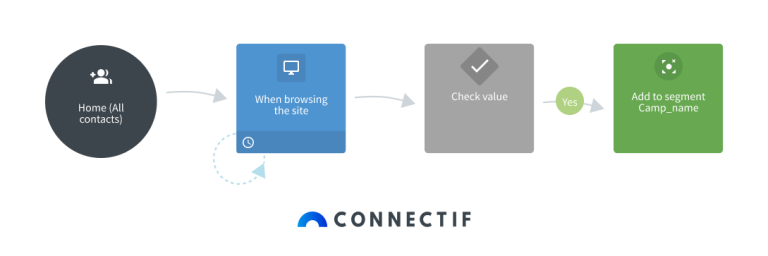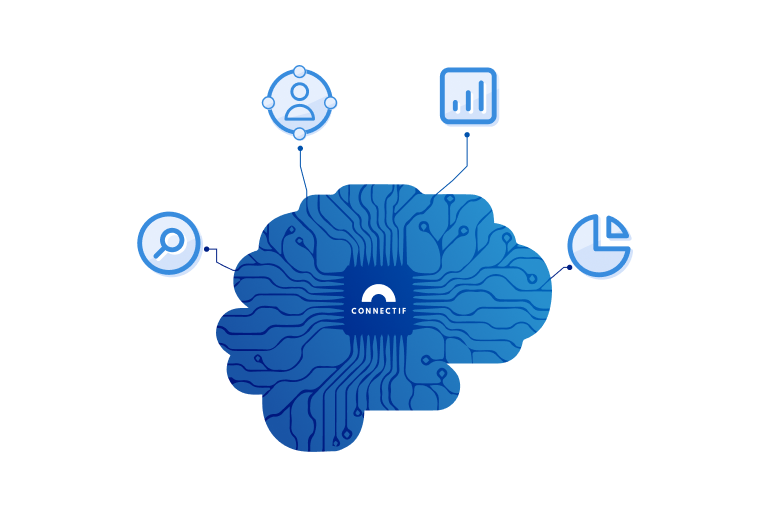Creating customer loyalty is an excellent way to increase your eCommerce site’s profitability, as it promotes purchase recurrence and increases the customer lifetime value rate (CLV). Earning the loyalty of your clients involves meeting their needs significantly while recognizing them as individuals. In this post we’ll talk about loyalty marketing. In addition, we’ll show you some workflows that can be easily automated in Connectif to connect with your users and boost your sales results.
Loyalty marketing is an approach based on the use of strategic, specific and relevant content in order to promote interaction with customers over time and at every stage of the customer journey.
Creating engagement with your audience means having valuable conversations with each client and discarding generic discounts and offers. People need to be heard and acknowledged in the online and offline world.
In the eCommerce sphere, this need can be tackled with audience micro-segmentation and content hyper-personalization.
The loyalty building process
Tracking your users’ digital footprint and collecting and analyzing data on their behavior, origin and profile (among other factors) can be extremely useful for marketers, as it allows them to strategically segment audiences. Marketing actions are thus more defined and engagement and results can be improved.
The process goes as follows:
- Segmentation and personalization: grouping users (current customers or leads) according to similar strategic criteria allows to deliver specific valuable suggestions that are not generic.
- Improving purchase experience: personalized communications improve the user’s experience on the shop and make transactions a more likely occurrence.
- Increasing conversion rates: if a client feels that they’re being taken care of, they’ll be more prone to shop.
- Increasing loyalty levels: good purchase experiences feel good and strengthen the clients’ ties and preference towards the brand.
- Increasing purchase recurrence: a loyal customer tends to shop again soon in comparison to a non-loyal one.
- Boosting profitability: more client satisfaction means more profitability, which makes any site more competitive.
How does loyalty affect your site’s profitability?
In short, when you interact with your clients and foster loyalty and brand preference, your revenue increases.
- A well-built loyalty marketing strategy creates trust: 85% of the customers trust eCommerce sites that take their time to help them with their purchase decisions instead of giving them a direct answer.
- Loyalty marketing encourages clicking: segmented email campaigns have 70% higher opening rates than mass campaigns. See it for yourself in our success cases here.
- Loyalty-building leads to quantifiable success: using personalization techniques has the potential of increasing conversion rates by 270%. See it for yourself in our success cases here.
- Loyalty-building maintains and improves the brand’s reputation: satisfied clients share their good experience with an average of 9 people. On the contrary, negative experiences are shared with an average of 16 people.
Building loyalty reduces costs: eCommerce sites that provide clients with a high-quality shopping experience can reduce their support costs up to 33%.
Essential workflows to put your loyalty marketing strategy into motion
As you can see, a good loyalty-building strategy starts off with an appropriate audience segmentation process.
By using behavior-based client data, you’ll be able to reach your users with relevant messaging in a personalized way. This will help your customers go through the sales funnel quicker.
Down below you’ll find a series of workflows tailored to create basic loyalty-building segments. These segments will allow you to hit your customers with personalized content:
1. Purchase-based segmentation:

Workflow goal:
To sort users according to purchase recency in order to deliver personalized and effective campaigns and offers. Recency allows you to evaluate the client’s interest in purchasing through the site based on how recently the customer completed their last purchase.
How it works:
In order to segment your users, you’ll need to collect data related to their purchasing habits first. You can start creating a personalized field named “Number of days since last purchase”. This value will be updated daily. Then, you can customize it and create segments as:
- Less than a month since their last purchase.
- 1-6 months since their last purchase.
- Over 6 months since their last purchase.
Having these segments at hand will allow you to strategically address your clients in order to create purchase recurrence. You’ll also be able to put specific strategies into motion to reactivate dormant customers.
2. Email segmentation

Workflow goal:
To discard inactive customers, focusing on building loyalty among active clients through email segmentation techniques (for instance, tracking the last time they opened an email message).
How it works:
This workflow was designed to run daily for every contact in your eCommerce list. It gets triggered every time an email is opened. The goal is to record the number of days that pass since the last opening.
It works similarly as the previous workflow. This means that the field “Number of days since last opening” can be customized to meet your site’s needs.
3. Media segmentation:
Workflow goal:
To optimize your communications using contact segmentation based on paid media campaign data from Google Ads, Facebook Ads, Criteo, etc.
How it works:
With this workflow, a check process is triggered when a contact browses your site. The goal is to verify if the page’s URL contains the campaign parameter that you want to base your segmentation on. If that’s the case, the contact will be added to a previously created segment.
The aim is to detect and group every user that reaches your site through a paid media campaign in order to target them with specific, personalized communications.
4. Personalized recommendations:
Workflow goal:
To regularly send personalized recommendations to a previously created audience segment that is considered strategic for your business. The goal is to strengthen the customer-site bond and increase loyalty levels.
How it works:
In the sample shown above, the workflow suggests sending a push notification, although an email message or sms could also be scheduled. In any of these instances, the workflow will firstly check that the contact is subscribed to the list, meaning that they have agreed to receive push notifications, newsletters or sms notifications, depending on the case.
This workflow is based on the “Champions” audience segment (those who have completed at least 5 purchases over the last year), but it can be adapted to your specific business and strategic needs.
5. Post-purchase survey:
Another key element of any loyalty-building strategy is getting feedback about the purchasing experience from the customer’s side.
Workflow goal:
To get valuable feedback from your clients using a satisfaction survey once their purchase is completed.
How it works:
As you can see on the workflow above, when a contact places an order, a Slide In that includes a post-purchase survey to rate their experience will be automatically displayed.
Want to use these workflows to earn your clients’ loyalty?
Connectif can be your best ally to put an infallible loyalty-building strategy into motion. It’s easy and quick: just use our workflow templates from your account if you want convenience. You can also design your own workflows from scratch. Remember to take action as soon as possible! Your site’s profitability is at stake.
If you’re not using Connectif for your marketing automation and loyalty marketing strategies yet, what are you waiting for? Request a demo here!








